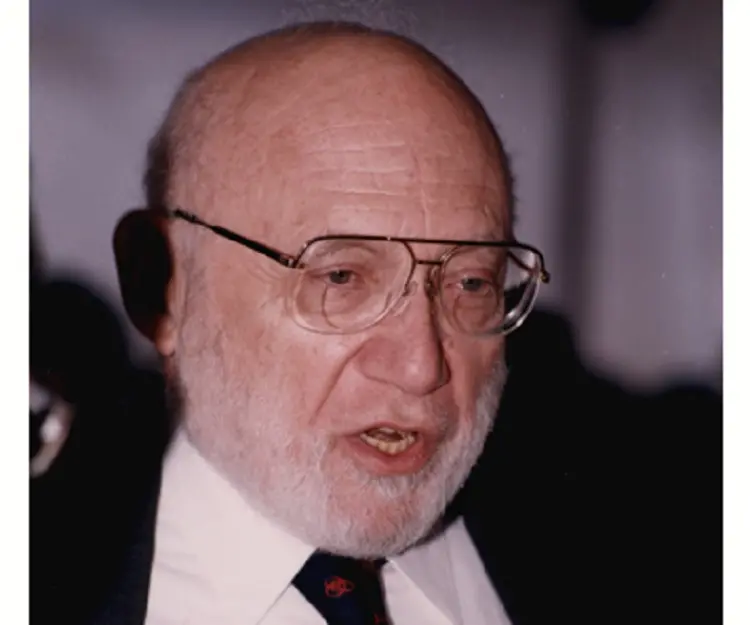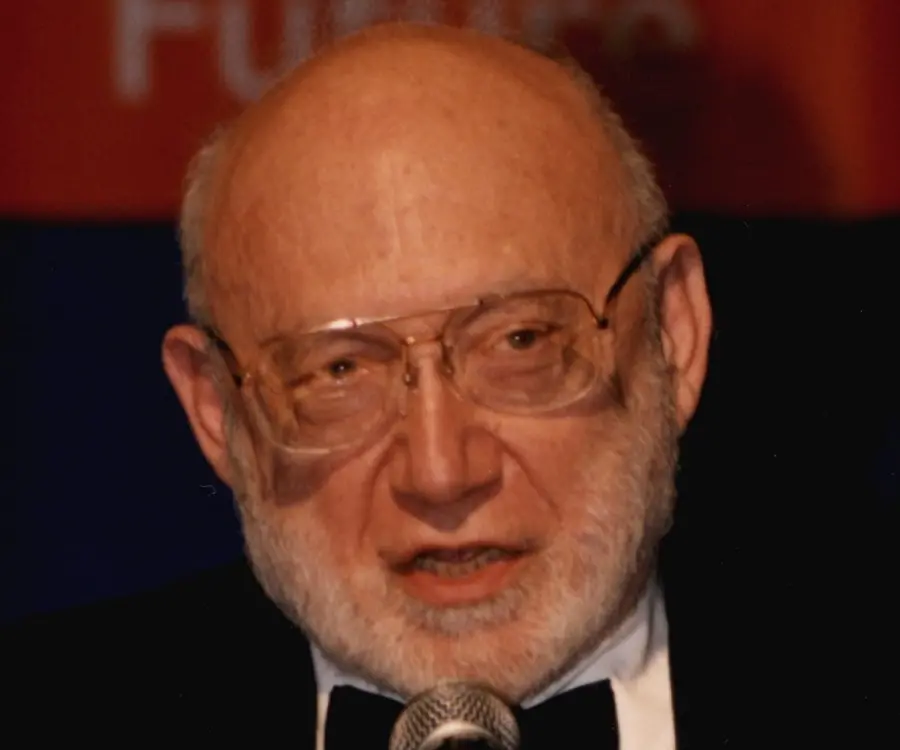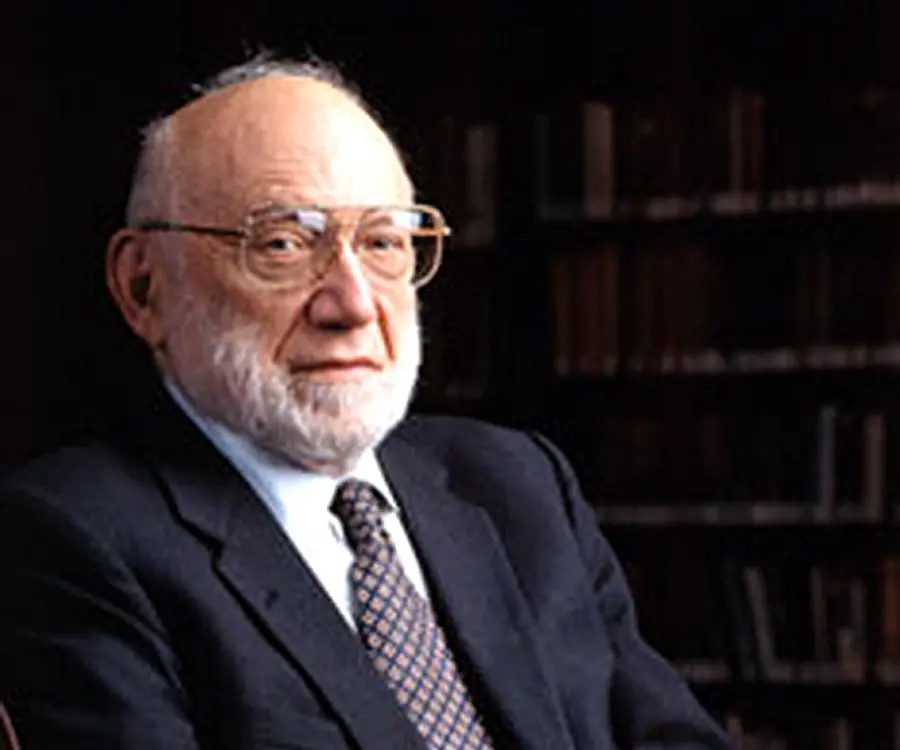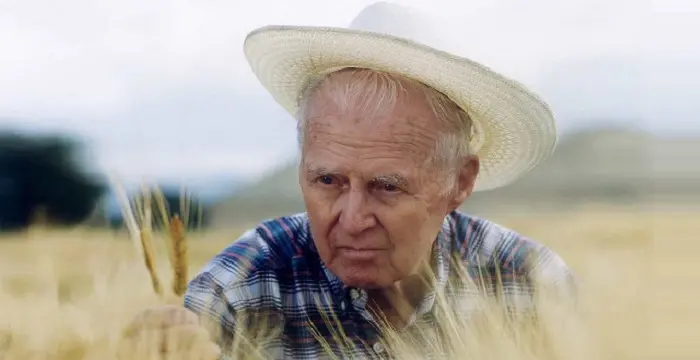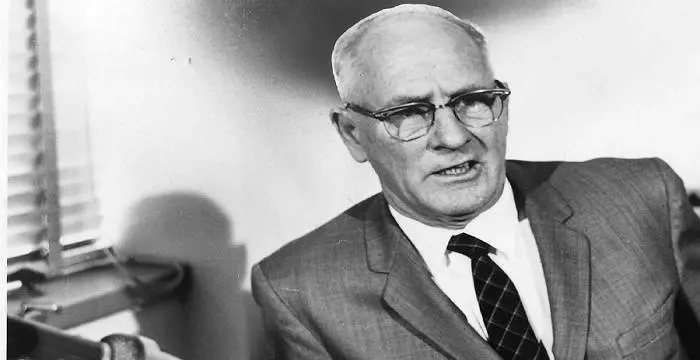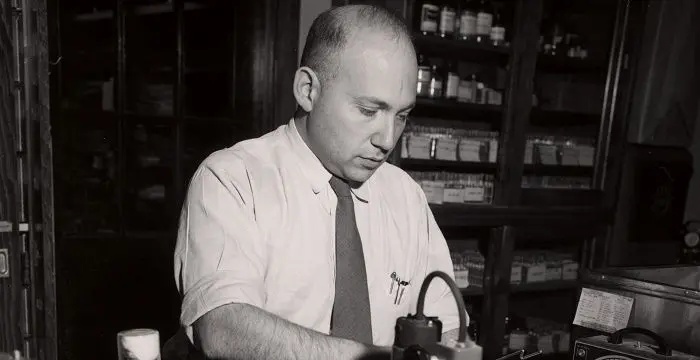
Joshua Lederberg - Geneticists, Family and Family
Joshua Lederberg's Personal Details
Joshua Lederberg was an American geneticist who won the 1958 Nobel Prize in Medicine
| Information | Detail |
|---|---|
| Birthday | May 23, 1925 |
| Died on | February 2, 2008 |
| Nationality | American |
| Famous | Scientists, Geneticists |
| Spouses | Esther Lederberg |
| Birth Place | Montclair, New Jersey, United States |
| Gender | Male |
| Sun Sign | Gemini |
| Born in | Montclair, New Jersey, United States |
| Famous as | Geneticist |
| Died at Age | 82 |
// Famous Scientists
Juliane Koepcke
Juliane Koepcke is a German-Peruvian biologist, who was the lone survivor among the 92 passengers and crew of the ill-fated LANSA Flight 508 that crashed in the Peruvian rainforest on 24 December 1971. Know more about her life in this biography.
Henry Cavendish
Henry Cavendish was a theoretical chemist and physicist, renowned for discovery of hydrogen and calculation of the mass of earth. To know more about his childhood, profile, timeline and career read on
Konstantin Tsiolkovsky
Konstantin Tsiolkovsky was a Russian rocket scientist and a pioneer of astronautics. This biography provides detailed information about his childhood, family, personal life, career, achievements, etc.
Joshua Lederberg's photo
Who is Joshua Lederberg?
Joshua Lederberg was an American geneticist who won the 1958 Nobel Prize in Medicine for discovering the mechanisms of genetic recombination in bacteria; he shared the Nobel Prize with George W. Beadle and Edward Tatum. Born in New Jersey, he initially wanted to acquire a medical degree. However, from his childhood, he had a natural aptitude for research work and while working for his medical degree at the Columbia University he began to experiment with the bread mold ‘Neurospora crassa’ under the mentorship of Francis Ryan. He soon realized that experimenting was more interesting than his medical studies and after two years at the medical school he took leave to join Edward L. Tatum to work on bacterial conjugation at the University of Stanford. Soon he established that E-coli bacteria can also reproduce sexually and was awarded Nobel Prize for this discovery at the age of thirty-three. He later established that genetic material could be moved from one strain of the bacterium Salmonella typhimurium to another using bacteriophage as an intermediary step. His works in this field established bacteria as a tool of genetic research. In addition, Lederberg also did extensive research on artificial intelligence and contributed in the development of Dendral, a pioneer project in artificial intelligence.
// Famous Geneticists
Norman Borlaug
Norman Borlaug was an American biologist known as the “Father of the Green Revolution”. This biography of Norman Borlaug provides detailed information about his childhood, life, achievements, works & timeline.
George Wells Beadle
George Wells Beadle was an American geneticist who won the 1958 Nobel Prize in Medicine. Check out this biography to know about his childhood, life, achievements, works & timeline.
Gregor Mendel
Gregor Mendel was an Austrian scientist and monk credited with being the father of modern genetics for his pioneering work in the study of heredity. This biography provides detailed information about his childhood, life, achievements, & timeline.
Childhood & Early Years
Joshua Lederberg was born on May 23, 1925, in Montclair, New Jersey. His father, Zwi H. Lederberg, was a Rabbi. His mother, Esther nee Goldenbaum, migrated from Palestine just two years prior to his birth. He was the eldest of his parent’s three sons.
When Joshua was six months old, the family moved to New York City and settled down in Washington Heights, a neighborhood in borough of Manhattan. He began his schooling at Public School 46 and later shifted to Junior High School 164.
Finally he graduated from Stuyvesant High School in 1941. While at school, Lederberg was allowed to conduct research in cytochemistry after school hours through American Institute Science Laboratory program. Works of H.G. Wells, Bernard Jaffe and Paul De Kruif also influenced him a lot.
After passing out from school, Joshua received a tuition scholarship from Hayden Trust. With that he enrolled at the University of Columbia as a premedical student with zoology as his major and received lab space to work on cytophysiology of mitosis in plants and theuses of genetic analysis in cell biology.
In 1942, he came in contact with Francis Ryan, who awakened in him an interest for biochemical genetics. He slowly began to find scientific research more challenging than the medical studies.
In 1943, Lederberg joined the clinical pathology laboratory at St. Albans Naval Hospital as part of military service. Here he was assigned to examine sailors' blood and stool samples for malaria.
Subsequently, he earned his bachelor’s degree in 1944 and entered the Columbia College of Physicians and Surgeons for his medical degree. At the same time, he continued with his experiments. However, once Oswald Avery published his paper on DNA, Lederberg’s aim in life took a different direction.
Career
Lederberg had an idea that bacteria passed down exact copy of genetic information and consequently, all cells in the lineage became its clone. He now began to work on that at the Columbia University. His work caught the attention of his mentor Francis Ryan, who recommended him to Edward L. Tatum.
Tatum was then working at the University of Yale on bacteria. He invited Lederberg to join his laboratory. Subsequently, Lederberg took one year’s leave from Columbia University and joined Tatum at Yale in March 1946. Here he was supported by Jane Coffin Childs Fund.
After intensive research with an Escherichia coli bacterium Lederberg and Tatum were able to establish that E-coli entered a sexual phase during which it could share genetic information through bacterial conjugation. In the same year, they published their findings in a paper titled, ‘Gene Recombination in Escherichia coli’.
As his one year leave from the Columbia University came to an end Lederberg decided not to return. Instead he decided to remain at Yale and earn his PhD, receiving the degree in 1948.
Meanwhile in 1947, he was appointed as an Assistant Professor of Genetics at the University of Wisconsin. In 1950, he was promoted to the post of Associate Professor and became a full Professor in 1954.
Concurrently, Lederberg continued his research on bacteria and in 1952, made another astonishing discovery in collaboration with his graduate student Norton D. Zinder. In a paper titled ‘Genetic Exchange in Salmonella’, they revealed a second process of gene exchange between bacteria.
They showed that a bacteria-infecting virus, known as bacteriophage, acting as a carrier agent could transfer bacterial gene from one bacterium to another. It first infects one bacterial cell and then reproduces itself inside using the bacteria's cell machinery. They called this phenomenon transduction,
Next in 1956, Joshua Lederberg, with Laurance Morse and Esther Lederberg, discovered specialized transduction. Later, he developed the technique of bacterial replica plating. It allowed bacterial colonies to be duplicated for further study.
In 1957, Lederberg was asked to organize the Department of Medical Genetics at the University of Wisconsin. He became its first Chairman and served in that capacity until 1958.
In 1959, he left the University of Wisconsin to establish the Department of Genetics at the Stanford University School of Medicine and became his first Chairman. Later in 1962, he became Director of the Kennedy Laboratories for Molecular Medicine in the same institute and served in that capacity until 1978.
Sometime during this period, he collaborated with Australian virologist Frank Macfarlane Burnet to study viral antibodies. From the middle of the 1960s, he also began to take keen interest in artificial intelligence and helped to develop Dendral (a pioneer project in artificial intelligence) along with Edward Feigenbaum, Bruce G. Buchanan, and Carl Djerassi.
In 1978, Lederberg left Stanford to become the President of Rockefeller University and remained in that position until he stepped down in 1990. Subsequently, he became Professor Emeritus of Molecular Genetics and Informatics at Rockefeller University.
Major Works
Lederberg is best remembered for his work on bacterium Escherichia coli. Earlier scientists were of the opinion that bacteria could only reproduce asexually; i.e. by splitting itself into two. Lederberg worked with Edward Tatum to show that E-coli could also reproduce sexually.
In a paper titled ‘Gene Recombination in Escherichia coli’, published in 1946, they showed that the amalgamation of two different strains of a bacterium resulted in genetic recombination, which led to the formation of a new bacterium. They also established that genetic systems of bacteria were quite analogous to that of higher organisms.
Lederberg is also remembered for his work on a phenomenon now known as transduction. In 1952, he along with Norton D. Zinder showed that bacterial gene could be transferred from one bacterium to another by means of a virus called bacteriophage
His work on astrobiology is also quite significant. When Sputnik was launched in 1957, it was Lederberg who cautioned that extraterrestrial microbes may gain entry into earth’s atmosphere onboard the spacecraft. He suggested that spacemen as well as spacecrafts should be quarantined on return to earth and checked for such microbes.
Awards & Achievements
In 1956, Joshua and Esther Lederberg were awarded the Pasteur Medal, for "their outstanding contributions to the fields of microbiology and genetics" by the Society of Illinois Bacteriologists.
In 1958, Joshua Lederberg received the Nobel Prize in Physiology and Medicine "for his discoveries concerning genetic recombination and the organization of the genetic material of bacteria". He was only thirty-three years old then.
Personal Life & Legacy
On 13, 1946, Lederberg married fellow scientist Esther Miriam Zimmer, who later became a noted microbiologist and a pioneer in bacterial genetics. For twenty years they worked together in different projects. However, personal competition slowly drove them apart and the couple divorced in 1966.
In 1968, Lederberg married psychiatrist Marguerite Stein Kirsch. The couple had a daughter named Anne Lederberg. Lederberg also had a stepson, David Kirsch, from Marguerite’s previous marriage. The couple remained married until his death.
Joshua Lederberg died on February 2, 2008, in New York. He was survived by his wife and two children.
In 2012, a large impact crater with a diameter of an 87 km in Xanthe Terra on the surface of Mars has been named after Lederberg.
Trivia
While Joshua Lederberg was a student of Edward L. Tatum his first wife Esther obtained her postgraduate degree at Stanford under George W. Beadles.
// Famous Gemini Celebrities peoples
Wentworth Miller
Wentworth Miller is an American actor and screenwriter who achieved recognition for his role in the TV series ‘Prison Break’.
Joyce Meyer
Joyce Meyer is a Christian author and speaker. This biography provides detailed information about her childhood, life, achievements, works & timeline
Zoe LaVerne
Zoe LaVerne is an American musical.ly star. Check out this biography to know more about her family, personal life, including her age, birthday, etc.
Joshua Lederberg's awards
| Year | Name | Award |
|---|---|---|
Other | ||
| 0 | 1958 - Nobel Prize in Physiology or Medicine | |
| 0 | 2006 - Presidential Medal of Freedom | |
| 0 | 1982 - William Procter Prize for Scientific Achievement | |
| 0 | 1989 - National Medal of Science for Biological Sciences | |
Joshua Lederberg biography timelines
- // 23rd May 1925Joshua Lederberg was born on May 23, 1925, in Montclair, New Jersey. His father, Zwi H. Lederberg, was a Rabbi. His mother, Esther nee Goldenbaum, migrated from Palestine just two years prior to his birth. He was the eldest of his parent’s three sons.
- // 1941Finally he graduated from Stuyvesant High School in 1941. While at school, Lederberg was allowed to conduct research in cytochemistry after school hours through American Institute Science Laboratory program. Works of H.G. Wells, Bernard Jaffe and Paul De Kruif also influenced him a lot.
- // 1942In 1942, he came in contact with Francis Ryan, who awakened in him an interest for biochemical genetics. He slowly began to find scientific research more challenging than the medical studies.
- // 1943In 1943, Lederberg joined the clinical pathology laboratory at St. Albans Naval Hospital as part of military service. Here he was assigned to examine sailors' blood and stool samples for malaria.
- // 1944Subsequently, he earned his bachelor’s degree in 1944 and entered the Columbia College of Physicians and Surgeons for his medical degree. At the same time, he continued with his experiments. However, once Oswald Avery published his paper on DNA, Lederberg’s aim in life took a different direction.
- // 1946In a paper titled ‘Gene Recombination in Escherichia coli’, published in 1946, they showed that the amalgamation of two different strains of a bacterium resulted in genetic recombination, which led to the formation of a new bacterium. They also established that genetic systems of bacteria were quite analogous to that of higher organisms.
- // 1946 To 1966On 13, 1946, Lederberg married fellow scientist Esther Miriam Zimmer, who later became a noted microbiologist and a pioneer in bacterial genetics. For twenty years they worked together in different projects. However, personal competition slowly drove them apart and the couple divorced in 1966.
- // Mar 1946Tatum was then working at the University of Yale on bacteria. He invited Lederberg to join his laboratory. Subsequently, Lederberg took one year’s leave from Columbia University and joined Tatum at Yale in March 1946. Here he was supported by Jane Coffin Childs Fund.
- // 1948As his one year leave from the Columbia University came to an end Lederberg decided not to return. Instead he decided to remain at Yale and earn his PhD, receiving the degree in 1948.
- // 1952Concurrently, Lederberg continued his research on bacteria and in 1952, made another astonishing discovery in collaboration with his graduate student Norton D. Zinder. In a paper titled ‘Genetic Exchange in Salmonella’, they revealed a second process of gene exchange between bacteria.
- // 1952Lederberg is also remembered for his work on a phenomenon now known as transduction. In 1952, he along with Norton D. Zinder showed that bacterial gene could be transferred from one bacterium to another by means of a virus called bacteriophage
- // 1956Next in 1956, Joshua Lederberg, with Laurance Morse and Esther Lederberg, discovered specialized transduction. Later, he developed the technique of bacterial replica plating. It allowed bacterial colonies to be duplicated for further study.
- // 1956In 1956, Joshua and Esther Lederberg were awarded the Pasteur Medal, for "their outstanding contributions to the fields of microbiology and genetics" by the Society of Illinois Bacteriologists.
- // 1957 To 1958In 1957, Lederberg was asked to organize the Department of Medical Genetics at the University of Wisconsin. He became its first Chairman and served in that capacity until 1958.
- // 1957His work on astrobiology is also quite significant. When Sputnik was launched in 1957, it was Lederberg who cautioned that extraterrestrial microbes may gain entry into earth’s atmosphere onboard the spacecraft. He suggested that spacemen as well as spacecrafts should be quarantined on return to earth and checked for such microbes.
- // 1958In 1958, Joshua Lederberg received the Nobel Prize in Physiology and Medicine "for his discoveries concerning genetic recombination and the organization of the genetic material of bacteria". He was only thirty-three years old then.
- // 1968In 1968, Lederberg married psychiatrist Marguerite Stein Kirsch. The couple had a daughter named Anne Lederberg. Lederberg also had a stepson, David Kirsch, from Marguerite’s previous marriage. The couple remained married until his death.
- // 1978 To 1990In 1978, Lederberg left Stanford to become the President of Rockefeller University and remained in that position until he stepped down in 1990. Subsequently, he became Professor Emeritus of Molecular Genetics and Informatics at Rockefeller University.
- // 2nd Feb 2008Joshua Lederberg died on February 2, 2008, in New York. He was survived by his wife and two children.
// Famous American peoples
Wentworth Miller
Wentworth Miller is an American actor and screenwriter who achieved recognition for his role in the TV series ‘Prison Break’.
Jason Simpson
Jason Simpson is the son of former NFL running back, broadcaster and actor O. J. Simpson. Check out this biography to know about his childhood, family, life, and little known facts about him.
Melissa Brim
Melissa Brim is the ex-girlfriend of former professional boxer Floyd Mayweather Jr. Check out this biography to know about her birthday, childhood, family life, achievements and fun facts about her.
Skai Jackson
Skai Jackson is an American child actress with huge fan following. Find more about her family & personal life, relationships, facts and more.
Joyce Meyer
Joyce Meyer is a Christian author and speaker. This biography provides detailed information about her childhood, life, achievements, works & timeline
Zoe LaVerne
Zoe LaVerne is an American musical.ly star. Check out this biography to know more about her family, personal life, including her age, birthday, etc.
Joshua Lederberg's FAQ
What is Joshua Lederberg birthday?
Joshua Lederberg was born at 1925-05-23
When was Joshua Lederberg died?
Joshua Lederberg was died at 2008-02-02
Which age was Joshua Lederberg died?
Joshua Lederberg was died at age 82
Where is Joshua Lederberg's birth place?
Joshua Lederberg was born in Montclair, New Jersey, United States
What is Joshua Lederberg nationalities?
Joshua Lederberg's nationalities is American
Who is Joshua Lederberg spouses?
Joshua Lederberg's spouses is Esther Lederberg
What is Joshua Lederberg's sun sign?
Joshua Lederberg is Gemini
How famous is Joshua Lederberg?
Joshua Lederberg is famouse as Geneticist



